Confocal conic sections
In geometry, two conic sections are called confocal, if they have the same foci. Because ellipses and hyperbolas possess two foci, there are confocal ellipses, confocal hyperbolas and confocal mixtures of ellipses and hyperbolas. In the mixture of confocal ellipses and hyperbolas, any ellipse intersects any hyperbola orthogonally (at right angles). Parabolas possess only one focus, so, by convention, confocal parabolas have the same focus and the same axis of symmetry. Consequently, any point not on the axis of symmetry lies on two confocal parabolas which intersect orthogonally (see below).
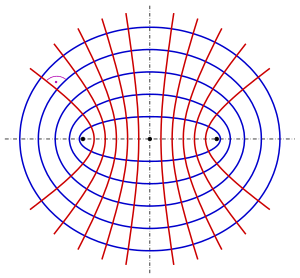
The formal extension of the concept of confocal conics to surfaces leads to confocal quadrics.
Confocal ellipses
An ellipse which is not a circle is uniquely determined by its foci and a point not on the major axis (see the definition of an ellipse as a locus of points). The pencil of confocal ellipses with the foci can be described by the equation
with semi-major axis as parameter. (The linear eccentricity is uniquely determined by the foci.) Because a point of an ellipse uniquely determines the parameter ,
- any two ellipses of the pencil have no points in common.
Confocal hyperbolas
A hyperbola is uniquely determined by its foci and a point not on the axes of symmetry. The pencil of confocal hyperbolas with the foci can be described by the equation
with the semi-axis as parameter. (The linear eccentricity is uniquely determined by the foci.) Because a point of the hyperbola determines the parameter uniquely,
- any two hyperbolas of the pencil have no points in common.
Confocal ellipses and hyperbolas
Common representation
From the previous representations of confocal ellipses and hyperbolas one gets a common representation: The equation
describes an ellipse, if , and a hyperbola, if .
In the literature one finds another common representation:
with the semi-axes of a given ellipse (hence the foci are given) and is the parameter of the pencil.
For one gets confocal ellipses (it is ) and
for confocal hyperbolas with the foci in common.
Limit curves
At position the pencil of confocal curves have as left sided limit curve (infinite flat ellipse) the line section on the x-axis and the right sided limit curve (infinite flat hyperbola) the two intervalls . Hence:
- The limit curves at position have the two foci in common.
This property appears in the 3-dimensional case (see below) in an analogous one and leads to the definition of the focal curves (infinite many foci) of confocal quadrics.

Twofold orthogonal system
Considering the pencils of confocal ellipses and hyperbolas (see lead diagram) one gets from the geometrical properties of the normal and tangent at a point (the normal of an ellipse and the tangent of a hyperbola bisect the angle between the lines to the foci) :
- Any ellipse of the pencil intersects any hyperbola orthogonally (see diagram).
Hence, the plane can be covered by an orthogonal net of confocal ellipses and hyperbolas.
This orthogonal net can be used as the base of an elliptic coordinate system.
Confocal parabolas
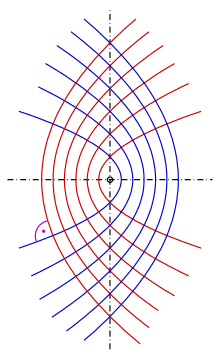
Parabolas possess only one focus. A parabola can be considered as a limit curve of a pencil of confocal ellipses (hyperbolas), where one focus is kept fixed, while the second one is moved to infinity. If one performs this transformation for a net of confocal ellipses and hyperbolas, one gets a net of two pencils of confocal parabolas.
The equation describes a parabola with the origin as focus and the x-axis as axis of symmetry. One considers the two pencils of parabolas:
- are parabolas opening to the right and
- are parabolas opening to the left
- with the focus in common.
From the definition of a parabola one gets
- the parabolas opening to the right (left) have no points in common.
It follows by calculation that,
- any parabola opening to the right intersects any parabola opening to the left orthogonally (see diagram). The points of intersection are .
( are normal vectors at the intersection points. Their scalar product is .)
Analogous to confocal ellipses and hyperbolas, the plane can be covered by an orthogonal net of parabolas.
The net of confocal parabolas can be considered as the image of a net of lines parallel to the coordinate axes and contained in the right half of the complex plane by the conformal map (see External links).
Graves's theorem: the construction of confocal ellipses by a string
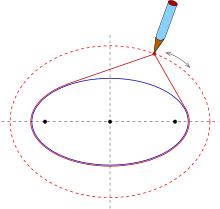
In 1850 the Irish bishop of Limerick Charles Graves proved and published the following method for the construction of confocal ellipses with help of a string:[1]
- If one surrounds a given ellipse E by a closed string, which is longer than the given ellipse's circumference, and draws a curve similar to the gardener's construction of an ellipse (see diagram), then one gets an ellipse, that is confocal to E.
The proof of this theorem uses elliptical integrals and is contained in Klein's book. Otto Staude extended this method to the construction of confocal ellipsoids (see Klein's book).
If ellipse E collapses to a line segment , one gets a slight variation of the gardener's method drawing an ellipse with foci .
Confocal quadrics

(red), (blue), (purple)

Definition
The idea of confocal quadrics is a formal extension of the concept of confocal conic sections to quadrics in 3-dimensional space:
Fix three real numbers with . The equation
- describes
- an ellipsoid if ,
- a hyperboloid of one sheet if (in the diagram: blue),
- a hyperboloid of two sheets if .
- For there are no solutions.
(In this context the parameter is not the linear eccentricity of an ellipse !)
Focal curves
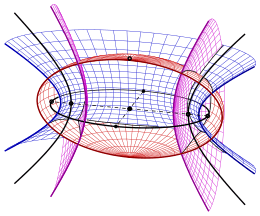

(ellipsoid, red), (1s hyperb., blue),
(1s hyperb., blue), (2s hyperb., purple)
bottom: Limit surfaces between the types
Limit surfaces for :
Varying the ellipsoids by increasing parameter such that it approaches the value from below one gets an infinite flat ellipsoid. More precise: the area of the x-y-plane, that consists of the ellipse with equation and its doubly covered interior (in the diagram: below, on the left, red).
Varying the 1-sheeted hyperboloids by decreasing parameter such that it approaches the value from above one gets an infinite flat hyperboloid. More precise: the area of the x-y-plane, that consists of the same ellipse and its doubly covered exterior (in the diagram: bottom, on the left, blue).
That means: The two limit surfaces have the points of ellipse
in common.
Limit surfaces for :
Analogous considerations at the position yields:
The two limit surfaces (in diagram: bottom, right, blue and purple) at position have the hyperbola
in common.
Focal curves:
One easily checks, that the foci of the ellipse are the vertices of the hyperbola and vice versa. That means: Ellipse and hyperbola are a pair of focal conics.
Reverse: Because any quadric of the pencil of confocal quadrics determined by can be constructed by a pins-and-string method (see ellipsoid) the focal conics play the role of infinite many foci and are called focal curves of the pencil of confocal quadrics.[2][3][4]
Threefold orthogonal system
Analogous to the case of confocal ellipses/hyperbolas one has:
- Any point with lies on exactly one surface of any of the three types of confocal quadrics.
- The three quadrics through a point intersect there orthogonally (see external link).

Proof of the existence and uniqueness of three quadrics through a point:
For a point with let be
.
This function has three vertical asymptotes and is in any of the open intervals a continuous and monotone increasing function. From the behaviour of the function near its vertical asymptotes and from one finds (see diagram):
Function has exactly 3 zeros with
Proof of the orthogonality of the surfaces:
Using the pencils of functions
with parameter the confocal quadrics can be described by . For any two intersecting quadrics with one gets at a common point
From this equation one gets for the scalar product of the gradients at a common point
which proves the orthogonality.

Applications:
Due to Dupin's theorem on threefold orthogonal systems of surfaces the following statement is true:
- The intersection curve of any two confocal quadrics is a line of curvature.
- Analogously to the planar elliptic coordinates there exist ellipsoidal coordinates.
In physics confocal ellipsoids appear as equipotential surfaces:
- The equipotential surfaces of a charged ellipsoid are its confocal ellipsoids.[5]
Ivory's theorem
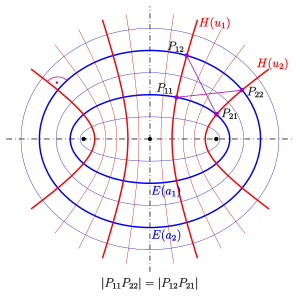
Ivory's theorem, named after the Scottish mathematician and astronomer James Ivory (1765–1842), is a statement on the diagonals of a net-rectangle, a quadrangle formed by orthogonal curves:
- For any net-rectangle, which is formed by two confocal ellipses and two confocal hyperbolas with the same foci, the diagonals have equal length (see diagram).
Intersection points of an ellipse and a confocal hyperbola:
Let be the ellipse with the foci and the equation
and the confocal hyperbola with equation
Computing the intersection points of and one gets the four points:
Diagonals of a net-rectangle:
In order to keep the calculation simple, it is supposed that
- , which is no essential restriction, because any other confocal net can be obtained by a uniform scaling.
- From the possible alternatives (see Intersection points, above)) only is used. At the end, one considers easily, that any other combination of signs yields the same result.
Let be two confocal ellipses and two confocal hyperbolas with the same foci. The diagonals of the four points of the net-rectangle consisting of the points
are:
Obviously the last expression is invariant, if one performs the exchange . Exactly this exchange leads to . Hence one gets :
The proof of the statement for confocal parabolas is a simple calculation.
Ivory even proved the 3-dimensional version of his theorem (s. Blaschke, p. 111):
- For a 3-dimensional rectangular cuboid formed by confocal quadrics the diagonals connecting opposite points have equal length.
See also
References
- Felix Klein: Vorlesungen über Höhere Geometrie, Sringer-Verlag, Berlin, 1926, S.32.
- Staude, O.: Ueber Fadenconstructionen des Ellipsoides. Math. Ann. 20, 147–184 (1882)
- Staude, O.: Ueber neue Focaleigenschaften der Flächen 2. Grades. Math. Ann. 27, 253–271 (1886).
- Staude, O.: Die algebraischen Grundlagen der Focaleigenschaften der Flächen 2. Ordnung Math. Ann. 50, 398 – 428 (1898)
- D. Fuchs, S. Tabachnikov: Ein Schaubild der Mathematik. Springer-Verlag, Berlin/Heidelberg 2011, ISBN 978-3-642-12959-9, p. 480.
- W. Blaschke: Analytische Geometrie. Springer, Basel 1954,ISBN 978-3-0348-6813-6, p. 111.
- G. Glaeser,H. Stachel,B. Odehnal: The Universe of Conics: From the ancient Greeks to 21st century developments, Springer Spektrum, ISBN 978-3-662-45449-7, p. 457.
- David Hilbert; Stephan Cohn-Vossen (1999), Geometry and the Imagination, American Mathematical Society, ISBN 0-8218-1998-4
- Ernesto Pascal: Repertorium der höheren Mathematik. Teubner, Leipzig/Berlin 1910, p. 257.
- A. Robson: An Introduction to Analytical Geometry Vo. I, Cambridge, University Press, 1940, p. 157.
- D.M.Y. Sommerville: Analytical Geometry of Three Dimensions, Cambridge, University Press, 1959, p. 235.
External links
- T. Hofmann: Miniskript Differentialgeometrie I, p. 48
- B. Springborn: Kurven und Flächen, 12. Vorlesung: Konfokale Quadriken (S. 22 f.).
- H. Walser: Konforme Abbildungen. p. 8.